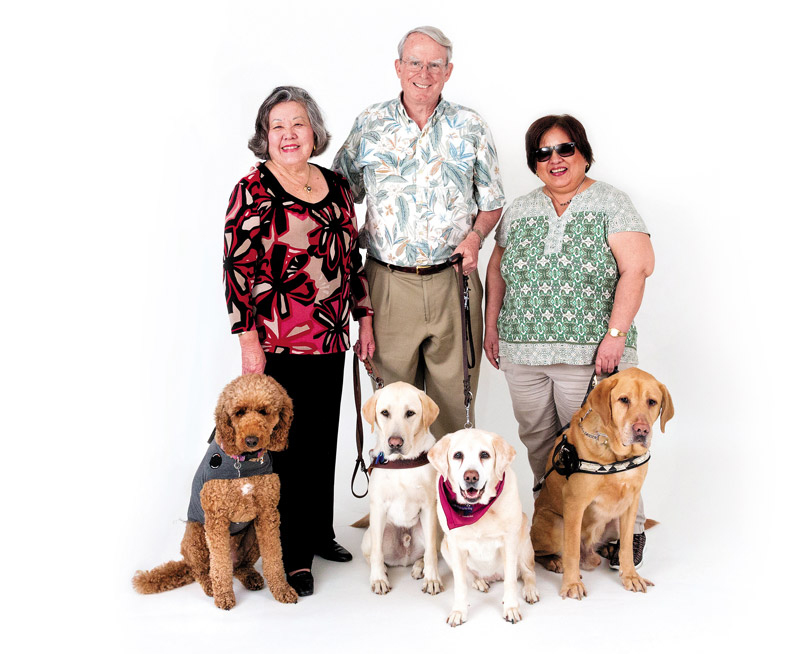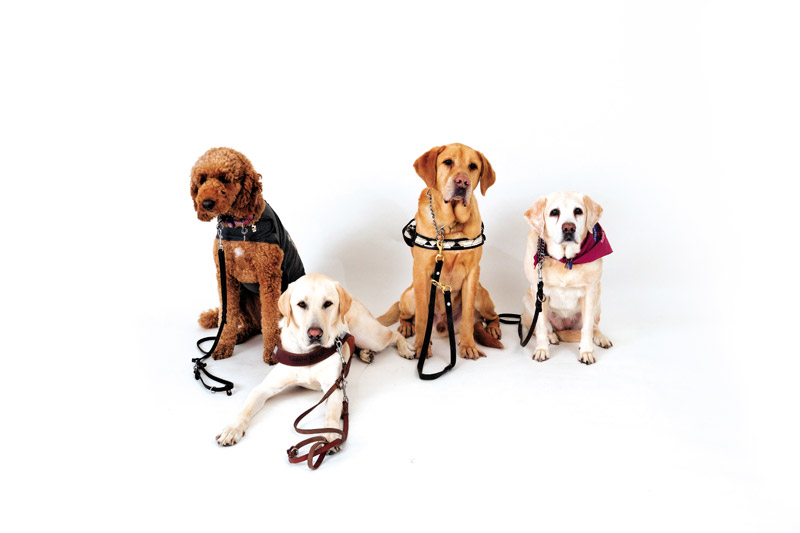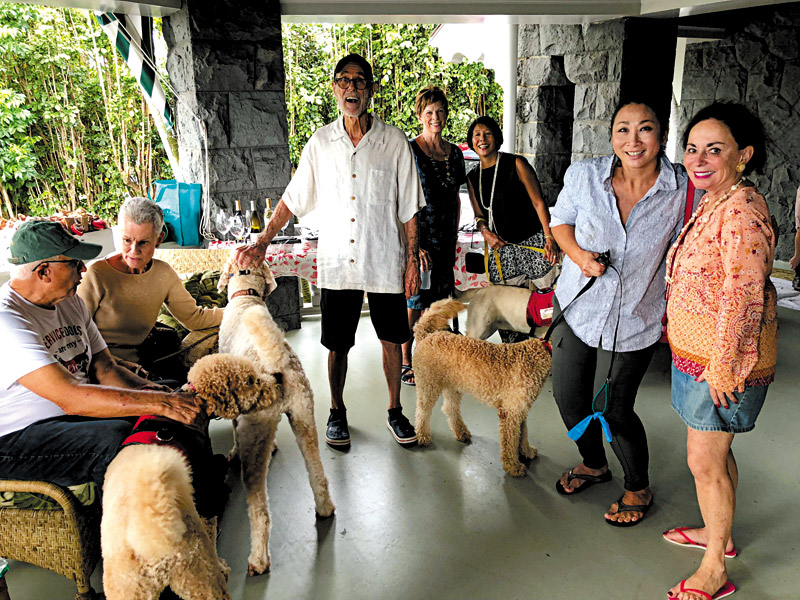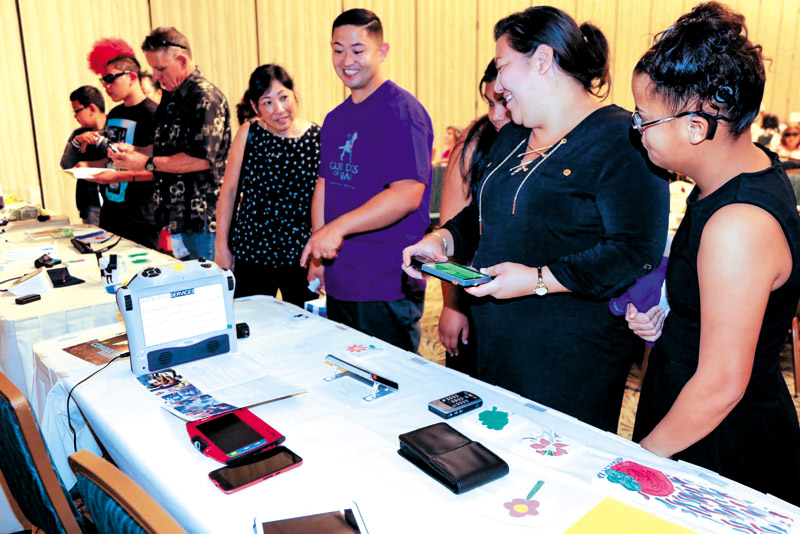Fur-ever Best Friends

Vickie and Jim Kennedy with Izzy, Buddy and Angela, and Jeanne Torres with Luke.
Chinese New Year celebrations on Feb. 16 bid adieu to the Year of the Rooster and ushered in the Year of the Dog — everyone’s favorite four-legged companion.
Of course, dogs are more than just the occasional garbage disposal or late-night cuddle buddy. Dogs offer emotional support in times of tragedy. They are used to seek out survivors after natural or manmade disasters, and patrol airports to keep travelers safe. Some are even being trained to detect life-threatening diseases in humans.
And right here in Hawai‘i, two nonprofit organizations — Hawai‘i Fi-Do Service Dogs and Guide Dogs of Hawai‘i — are connecting these furry friends with those who need them. fter a career in banking that spanned more than 35 years, Jim Kennedy changed course and joined Hawai‘i Fi-Do Service Dogs as its executive director in January 2015. Now, he oversees an organization that trains and provides service dogs to people with disabilities other than blindness, such as those with severe muscle control or balance issues.
“One of the definitions of a service dog is it must be trained to perform meaningful tasks,” he says.
As such, Hawai‘i Fi-Do dogs are molded to suit each individual’s needs, and lessons abide by in-house methods and those laid out by Assistance Dogs International. Some service dogs might be taught to assist their handlers with upper-body support, while others simply help them move about with ease. All are trained to complete simple tasks, too, like opening doors, turning on lights and picking up dropped items.
It’s a comprehensive process —led by founder, program director and head trainer Susan Luehrs — that also trains each dog’s carefully vetted handler. It takes roughly two years to complete, and Kennedy estimates that about five to six dogs graduate each year — not without the dedicated help of volunteers, he adds. Support doesn’t stop there either, because as long as Hawai‘i Fi-Do recipients remain in the state, they can always count on the organization for continued training and assistance.

Izzy, Buddy, Luke and Angela
“One of the biggest benefits from being with Hawai‘i Fi-Do is I feel like I have ‘ohana,” says Patty Rickmann, a beneficiary of the program paired with Izzy. “As you become less mobile … you have that
tendency to shrink your world, and I want my world to stay as big as (it) can.”
The job Kennedy has now may seem like a stark contrast to his previous career, but supporting the community is nothing new for the Indianapolis native. In fact, within a year of graduating college, Kennedy was volunteering with March of Dimes and his commitment to giving back didn’t stop there.
But his role with Hawai‘i Fi-Do has an even deeper, personal significance than that. His wife, Vickie, lost her sight years ago and relies on current guide dog Buddy.
“I know firsthand how that changes the life of the person who gets a good, well-trained service dog,” he says.
“I respect so much what a service dog —not just a guide dog; any quality, well-trained service dog — can do for its partner, and it’s exciting for me to know that in my own little way, I’m making a contribution to this organization,” Kennedy adds.
It was a degenerative disease that gradually began to take Vickie’s sight 40 years ago.
Buddy is her third service dog from Guide Dogs for the Blind located in San Rafael, California. He, along with Vickie’s previous dogs Freida and Angela, the latter now retired, have, without question, proven to be helpful in more ways than one. Having a guide dog has not only given Vickie a companion and the means and confidence to move about freely and safely, but also serves as an icebreaker for those who feel unsure when it comes to approaching a blind person.

Hawai‘i Fi-Do Service Dogs volunteers smile for a photo at an appreciation luncheon. PHOTO COURTESY JIM KENNEDY
“When I used to be a cane traveler, no one ever came up to me and said, ‘My, what a beautiful cane you have,'” she says. “But they just love dogs, and they are more apt to come up to you and talk about your dog.”
This sort of ease in life that a guide dog can provide to the blind is a message Guide Dogs of Hawai‘i has made its mission to spread.
Initially established as Eye of the Pacific (the organization went through a couple of name changes before landing on its current moniker in 2014), the nonprofit first got its start to connect blind individuals in Hawai‘i with guide dogs — an almost impossible task at the time. While dogs from the Mainland could enter the state, having to undergo quarantine often deteriorated their training. So the organization set up contracts with rabies-free countries Australia and New Zealand instead.
Eventually, guide dogs and service dogs were permitted entry to the state without having to wait in quarantine. Once that was no longer a pressing issue, Guide Dogs of Hawai‘i expanded its focus to other ways it could help Hawai‘i’s blind community.
Some of that has involved creating a variety of social activities and services for the blind community here in Hawai‘i. It also offers programs that teach the blind how to use technology to their advantage (see accompanying article on page 22). The organization, which does not provide guide dogs, teams up with agencies for that purpose and offers continued support once an individual receives their working partner, too.
But a lot of what Guide Dogs of Hawai‘i focuses on in the midst of all this is advocating for the potential benefits the blind may have by working with a guide dog. Some, explains Jeanne Torres, Guide Dogs of Hawai‘i executive director, prefer to use a cane because it requires less responsibility. A dog is a lot of work, she points out. But in choosing that route, there is so much an individual might be missing out on.
“We still believe that guide dogs do enhance mobility and we encourage the kids that come in to our program — introduce them to guide dogs and continuously talk to the younger population because that’s the population that we want to convince that they can potentially benefit from the use of a guide dog. … It’s the younger ones I’m really focusing on because they’ve got the rest of their lives,” says Torres, who relies on guide dog Luke.
“I wouldn’t be able to independently make it to the bus stop because I’d be walking in circles. I want to be able to just go up the street to the store, you know, do whatever I want to do,” she adds. “That’s what guide dogs do. They give you that ultimate level of independence that’s almost near sight, but not quite there.”
Guiding Tech
In expanding its focus, Guide Dogs of Hawai‘i discovered that technology was quickly creating new ways to help the blind. So it set up two programs to connect those resources with a community that needs it.

Last year, students from Guide Dogs of Hawai‘i’s Get Ahead with Technology program participated in the second annual student-led conference, sharing their experiences and the adaptive/technology aids they use. PHOTO COURTESY GUIDE DOGS OF HAWAI‘I
The first is called Get Ahead with Technology, which works with individuals ages 2-22 and teaches participants how to use adaptive/technology aids. The second, SHINE, helps seniors. Vickie Kennedy, for instance, learned how to use an iPhone through the organization.
“It’s really, I would like to say, an eye-opening experience,” says Kennedy. “I put off using an iPhone. I was so intimidated; I felt so stupid. Now it’s like … I don’t know what to do without it.”
That isn’t the only piece of technology available either. Kennedy and Torres list machines that scan and report back colors, and apps that read currency and communicate whether it’s the font of a bill or back.
It’s at this point in the conversation that Patty Rickmann, a Hawai‘i Fi-Do Service Dogs graduate, chimes in.
“I just went through a series of shots to not go blind for macular degeneration,” she says. “I was already experiencing wavy stuff and the telephone poles bending over and things like that, so I was really freaked out. But now that I hear this, it’s like I’m not near as afraid to go blind as I was.”
“It’s fun actually,” says Jeanne Torres, Guide Dogs of Hawai‘i executive director, with a little laugh.
“You’re only as limited as you want to be,” adds Kennedy. “It’s a whole new world.”





